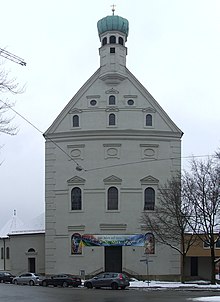St. Maximilian (Augsburg)
The parish church of St. Maximilian , also St. Max , formerly the Franciscan monastery church of the Holy Sepulcher , is a Catholic church in the deanery in Augsburg-Mitte, which forms a parish community with St. Georg and St. Simpert . It is one of the first churches in southern Germany to be rebuilt after the Second World War . The church is registered as an architectural monument in the Bavarian list of monuments.
history
Previous construction
As early as the first half of the 12th century there was a chapel on the so-called Weinmarkt (today Maximilianstrasse ) in Augsburg , which was dedicated to the Holy Sepulcher . After an exchange between the cathedral chapter and the city in 1608, the dilapidated church was demolished. Remnants of the old walls were incorporated into the imperial city department store built by the city architect Elias Holl in 1611 (today at the corner of Maximilianstrasse and Heilig-Grab-Gasse).
The church building rights and patronage of the Holy Sepulcher were transferred to the current location of the church. The property was a gift from the Fugger to the Franciscans , who had a new church built there in 1611 next to their newly founded Franciscan monastery at the Holy Sepulcher . The plans probably came from Esaias Holl, a brother of Elias Holl. The consecration was made on October 26, 1613 by the Augsburg bishop Heinrich von Knöringen . The still preserved high altar painting Allerheilgen was created by the Augsburg artist Johann Rottenhammer . The church and monastery were made Baroque in 1674.
With the secularization , the monastery was abolished in 1805 and completely vacated by 1808. The church then temporarily served as a salt store and the monastery as a barracks. On February 19, 1809, King Maximilian I Joseph elevated the former monastery church to the parish church of the Jakobervorstadt district . Probably on the initiative of his minister Maximilian Graf von Montgelas , the church was placed under the new patronage of Bishop Maximilian von Celeia in 1810 . A figure of St. Maximilian donated the king to the church personally.
Destruction and rebuilding
With the air raids on Augsburg from February 25 to 26, 1944, the church and the former monastery building were almost completely destroyed. The once rich interior also fell victim to the flames. Only a few works of art, including several figures of saints, could be relocated beforehand. After the wall collapsed at a later date on May 11, 1946, only the western gable pane of the church, which was included in the later construction of the new church, and a small remainder of the former monastery building (today the parish hall) were preserved.
The reconstruction according to plans by the architect Dominikus Böhm in a simplified form and without the Holy Sepulcher Chapel began in 1946 with the removal of rubble. The costs amounted to 240,000 marks. Most of the building material used was rubble stones from the old church. The topping-out ceremony took place in October 1949, and the new church was consecrated on April 15, 1951. The art academy director Franz Nagel took on the painting of the church ceiling and altars. The sculptures are by Stephan Geiger.
architecture
The west gable facade of the church has three window axes. An octagonal gable tower from around 1650 rises on a console. A small round building is attached to the right of the entrance. The nave has a barrel vault.
gallery
literature
- Hugo Schnell: St. Maximilian Augsburg , 1960
- Helmut Rößle: Houses of God in the Bomb War - The Destruction of Augsburg Churches in the Second World War. Regio Akademica Verlag, Augsburg 2004, pp. 36–37
Web links
Individual evidence
- ↑ List of monuments for Augsburg (PDF) at the Bavarian State Office for Monument Preservation, monument number D-7-61-000-236
- ^ Augsburg & its surroundings . Volkhart, 1838 ( google.de [accessed on August 17, 2018]).
Coordinates: 48 ° 22 ′ 23.9 ″ N , 10 ° 54 ′ 15.5 ″ E










